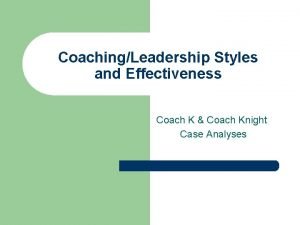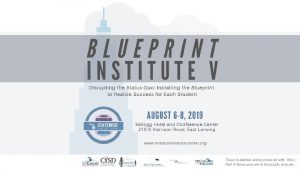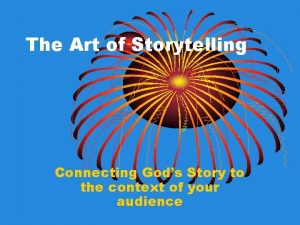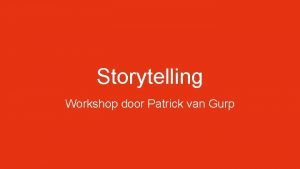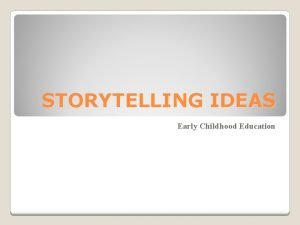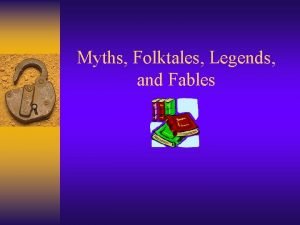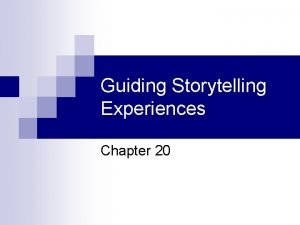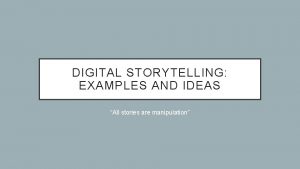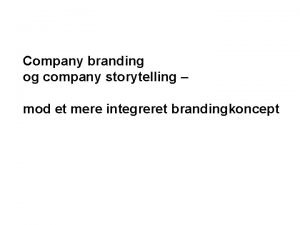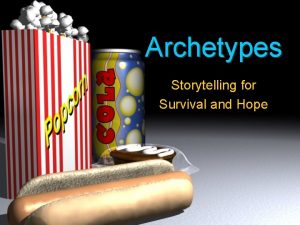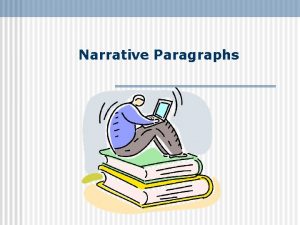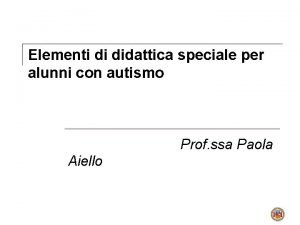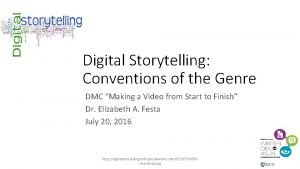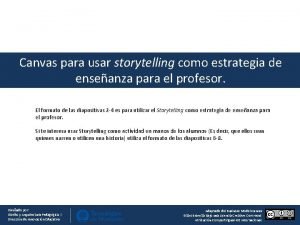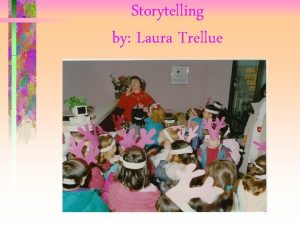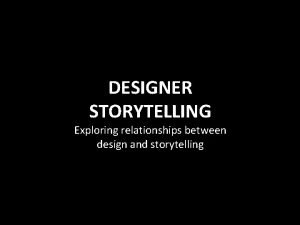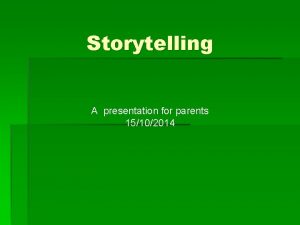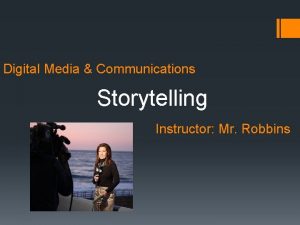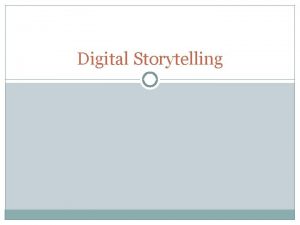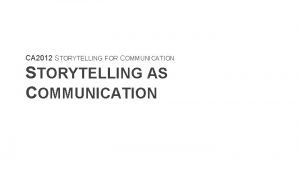THE POWER OF STORYTELLING ALI COACH GATHERING Monday




















- Slides: 20

THE POWER OF STORYTELLING ALI COACH GATHERING Monday, October 20, 2013 2: 00 -4: 30 Annabelle Nelson, Ph. D. Professor Fielding Graduate University anelson@fielding. edu

AGENDA 2: 00 -2: 15 -2: 30 -2: 45 -3: 00 -3: 15 3: 00 -4: 00 -4: 15 -4: 30 Welcome & Story Dyads-My Favorite Story & Archetype Power of Archetypes Improv Story Structure of Story Coaching Technique 1. Test & Emotion in Body 2. Imagery Exercise for Archetype 3. Story Work Sheet 4. Tell a Story Applications Q & A

GOALS Share information on storytelling for insight, psychological growth and emotional clearing. Create experiences of storytelling. Showcase a storytelling protocol to use for coaching.

EARLY MEMORY OF AN STORY Early Memory Think back, think back, when someone was telling or reading you a story, an experience you really liked, where were you, who was with you, any noticeable perceptual details? Which character did you like, which character captured your imagination? Any color you associate with the color, and noticeable characteristics?

WHAT IS STORYTELLING An oral account Cultural stories are ancient human technology 1. The coherence in one’s life from the past and the hope in one’s life for the future. 2. The awareness that adversity will come in life. 3. The ability to laugh at pitfalls 4. Beliefs. 5. How to stay safe. 6. Identification with a group or tribe. 7. Positive character traits 8. How to withstand negative forces and to overcome adversity. 9. Acceptance of one’s role or destiny in life.

STORYTELLING IN YOUR PRACTICE Humans are natural storytellers to communicate and make sense of their lives. Stories move humans into liminal spaces tapping into the collective unconscious of human patterns. What’s an example of storytelling in your practice?

TELLING STORIES & LISTENING STORIES Helps humans identify with an archetype which naturally propels human towards conscious awareness.

STORYTELLING & HUMAN DEVELOPMENT Human development includes spiritual awareness and emotional health End goal = conscious awareness, need to clear channel between conscious mind and spiritual Self in unconscious Unconscious becomes conscious & conscious becomes unconscious As this happens shadow material and repressed emotional issues and karma released

BENEFITS OF ARCHETYPE FOCUS Teaching an inner focus over times helps establish ego integrity by allowing emotional material to clear Jerome Kagan- interindividual stage Erikson- generativity

ARCHETYPE ALLOWS UNCONSCIOUS TO OPEN

EPISTEMOLOGICAL ASSUMPTIONS There is a creative force in the unconscious that can lead humans to emotional healing and growth. The language of the unconscious is metaphoric and imagistic. Aligning with an archetype or energy patterns can “hold” the unconscious open in a safe manner, releasing emotional material: release emotions & receive insights from intuition Stories contain human wisdom and the characters and symbols can resonate in the individual unconscious to activate the creative force.

IMPROV A STORY

STORYTELLING CYCLE: THE STAGES

COACHING TECHNIQUE: FIND A TEST Think back to a time in the last 12 months or so to a particularly difficult event, possibly termed a “test”. Where were you? What was happening? Who were you with? Imagine as if it was happening right now in your mind’s eye. What colors do you remember? Then speed time a bit and imagine yourself several months past this event. What happened? How did you face this? Were there any helpers? Tell your partner about it. (Narrative prompt, “Tell me about…. . ).

IMAGERY OF AN ARCHETYPE

TESTS & STORYTELLING

TELL YOUR STORY

SUMMING UP & CLOSE What to take away, how to apply?

COMING SOON Archetype Imagination: Coaching and Therapy for Spiritual Wisdom by Annabelle Nelson Coming 2014 Jessica Kingsley Ltd Publisher, London

REFERENCES Cajete, G. A. (1994). Look to the mountain: an ecology of indigenous education. Skyland, NC: Kivaki Press Campbell, J. (1972). The hero with a thousand faces. Princeton, New Jersey: Princeton University Press. Houston, J. (2000). Myths of the future. The Humanistic Psychologist. 28 (13), 43 -58. Mellon, N. (1992). Storytelling and the art of imagination. Rockport, MA: Element, Inc. Nelson, A. (2009). Storytelling and transformative learning. In Learning Space, Cultural Diversity and the Performing Art: New Dimensions in Transformative Education. Ed. B. Fisher-Yoshida, K. D. Geller & S. Schapiro. New York: Peter Lang. Nelson, A. (2007). The spacious mind: using archetypes for transformation towards Wisdom. The Humanistic Psychologist. 35, 235 -246. Tafoya, T. (1982). Coyote’s eyes: Native cognition styles. Journal of American Indian Education, 11, 21– 33. Von Franz, M. -L. (1996). The interpretation of fairy tales. Boston: Shambhala.
 Coach k leadership style
Coach k leadership style Unit one the power of storytelling
Unit one the power of storytelling Data storytelling with power bi
Data storytelling with power bi Power triangle
Power triangle Materials title
Materials title Total physical response storytelling
Total physical response storytelling Gods of storytelling
Gods of storytelling Storytelling randsatd
Storytelling randsatd Suspend
Suspend Non linear narrative definition
Non linear narrative definition Stories once passed down orally
Stories once passed down orally Chapter 20 guiding storytelling experiences
Chapter 20 guiding storytelling experiences Examples of digital storytelling
Examples of digital storytelling Digital storytelling meaning
Digital storytelling meaning Corporate storytelling
Corporate storytelling Death and rebirth archetype examples
Death and rebirth archetype examples Storytelling mod
Storytelling mod Paragraph narrative
Paragraph narrative Autismo metodologie e strategie didattiche
Autismo metodologie e strategie didattiche Storytelling conventions
Storytelling conventions Storytelling canvas example
Storytelling canvas example
